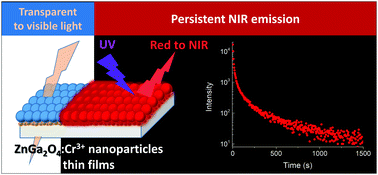Persistent luminescence of transparent ZnGa2O4:Cr3+ thin films from colloidal nanoparticles of tunable size†
Abstract
We report on the fabrication of ZnGa2O4:Cr3+ transparent thin films and the evaluation, for the first time in the literature, of their persistent red to NIR emission. For this purpose, we have used a simple and economic global strategy based on wet processing methods from colloidal nanospheres with uniform size. A microwave-assisted hydrothermal method was first developed for the synthesis of precursor particles, which allows size tuning from 300 nm to 30 nm through simple modification of the Zn2+ precursor and the Cr3+ content of the starting solutions. ZnGa2O4:Cr3+ transparent thin films over quartz substrates were then easily fabricated by spin coating, and their structural and optical characteristics were analyzed in detail after annealing at high temperature to elucidate the effect of processing temperature and particle size on the properties of the films. Indeed, our results indicate that high temperature annealing does not compromise the transparency of the films but improves their photoluminescence. In addition, the analysis reveals that persistence luminescence in our films is rather independent of the size of the precursor nanoparticles. Due to their transparency and persistent emission properties, films fabricated from colloidal suspensions of ZnGa2O4:Cr3+ nanoparticles show great potential for application in the fields of chemical sensing, information storage, labelling, and anti-counterfeiting technology.



 Please wait while we load your content...
Please wait while we load your content...